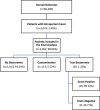Intrapartum fever complicated with maternal bacteremia: prevalence, bacteriology, and risk factors
- PMID: 38797768
- PMCID: PMC11169021
- DOI: 10.1007/s00404-024-07564-5
Intrapartum fever complicated with maternal bacteremia: prevalence, bacteriology, and risk factors
Abstract
Purpose: To assess the prevalence, microbial profile, and clinical risk factors of maternal bacteremia associated with intrapartum fever (IPF).
Methods: A retrospective cohort study, in a single tertiary university-affiliated medical center between 2012 and 2018. Demographic and labor characteristics of women, who delivered at term (37+0/7-41+6/7) and developed bacteremia following IPF were compared to a control group of women with IPF but without bacteremia.
Results: During the study period there were 86,590 deliveries in our center. Of them, 2074 women (2.4%) were diagnosed with IPF, of them, for 2052 women (98.93%) the blood maternal cultures were available. In 26 patients (1.25%) maternal bacteremia was diagnosed. A lower rate of epidural anesthesia (84.6% vs 95.9%, p = 0.02) and a higher rate of antibiotics prophylaxis treatment prior to the onset of fever (30.8%.vs 12.1%, p = 0.006) were observed in patients who developed maternal bacteremia in comparison to those who have not. Maternal hyperpyrexia developed after initiation of antibiotics or without epidural anesthesia remained significantly associated with maternal bacteremia after applying a multivariate analysis, (Odds Ratio 3.14 95% CI 1.27-7.14, p = 0.009; 4.76 95% CI 1.35-12.5, p = 0.006; respectively).
Conclusion: Maternal fever developing after initiation of antibiotics or without epidural is associated with maternal bacteremia.
Keywords: Antibiotics; Bacteremia; Intrapartum fever.
© 2024. The Author(s).
Conflict of interest statement
All authors report no conflict of interest.
Similar articles
-
Clinical and microbiological outcomes of maternal bacteremia: the role of intrapartum antibiotic use, insights from an 11-Year cohort study.J Matern Fetal Neonatal Med. 2025 Feb 11;38(1):2466216. doi: 10.1080/14767058.2025.2466216. Epub 2025 Feb 16. J Matern Fetal Neonatal Med. 2025. PMID: 39956637
-
Incidence of fever in labor and risk of neonatal sepsis.Am J Obstet Gynecol. 2017 Jun;216(6):596.e1-596.e5. doi: 10.1016/j.ajog.2017.02.022. Epub 2017 Feb 16. Am J Obstet Gynecol. 2017. PMID: 28216060
-
Risk Factors and Safety Analyses for Intrapartum Fever in Pregnant Women Receiving Epidural Analgesia During Labor.Med Sci Monit. 2021 Mar 15;27:e929283. doi: 10.12659/MSM.929283. Med Sci Monit. 2021. PMID: 33720924 Free PMC article.
-
Epidural-Related Fever and Maternal and Neonatal Morbidity: A Systematic Review and Meta-Analysis.Neonatology. 2020;117(3):259-270. doi: 10.1159/000504805. Epub 2020 Jan 28. Neonatology. 2020. PMID: 31991422
-
The association between epidural labor analgesia and maternal fever.Clin Perinatol. 2013 Sep;40(3):385-98. doi: 10.1016/j.clp.2013.06.002. Epub 2013 Jul 19. Clin Perinatol. 2013. PMID: 23972746 Review.
Cited by
-
Maternal bacteremia in intrapartum fever: the role of ampicillin resistance and prolonged membrane rupture-a retrospective comparative study.Arch Gynecol Obstet. 2025 Aug;312(2):451-460. doi: 10.1007/s00404-025-08030-6. Epub 2025 Apr 23. Arch Gynecol Obstet. 2025. PMID: 40266333 Free PMC article.
References
-
- Verani JR, McGee L, Schrag SJ. Morbidity and mortality weekly report prevention of perinatal group B streptococcal disease. Revised guidleines from CDC, 2010. Morb Mortal Wkly Rep. 2010;59(RR10):1–36. - PubMed
Publication types
MeSH terms
Substances
LinkOut - more resources
Full Text Sources
Medical



